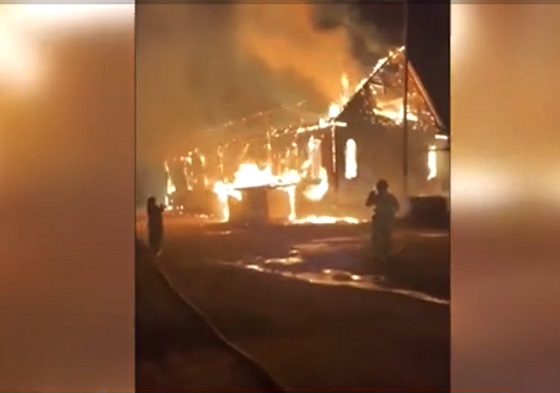Alberta
Rocky View County murder. RCMP charge one with first degree murder; searching for second suspect

News release from Strathmore RCMP
The Alberta RCMP have now laid charges in connection with the tragic shooting which occurred in Rocky View County on Aug. 6, 2024. RCMP have charged Edmonton resident 35-year-old Arthur Wayne Penner with the first-degree-murder of Airdrie resident Colin John Hough as well as attempted murder of another individual. Penner has been arrested and taken before a justice of the peace. He has been remanded into custody with his next court date set for Aug. 15, 2024, at the Alberta Court of Justice in Airdrie.
Additionally, RCMP continue to search for the second suspect in the shooting. Elijah Blake Strawberry, 28-years-old, now has a warrant for his arrest for the second-degree-murder of Colin Hough. RCMP are asking for the public’s assistance in locating Strawberry.
Elijah Strawberry is described as:
- Light complexion
- 6 feet 1 inch tall
- 169 pounds
- Several arm and face tattoos.
- Brown Hair
Elijah Strawberry is considered armed and dangerous. If seen do not approach dial 911 immediately.
The Alberta RCMP wish to offer a timeline into the investigation that led to both an arrest and a warrant for arrest.
On Aug. 6, 2024, around noon hour, officers from the Strathmore RCMP received a report of two men who had been shot while doing work along a roadway on Township Road 250 and Range Road 281 in Rocky View County. Upon arriving on scene, emergency crews discovered that Colin Hough and a 39-year-old victim had both been shot during an attempted robbery by two, then unknown, individuals. The suspects burnt the stolen vehicle they arrived to the scene in, and stole one of the victim’s Rocky View County pick-up trucks.
Responding officers were able locate the suspects in the Rocky View County pick up truck and engaged in a pursuit, however the suspects were successful in evading police.
Soon after, using the Rocky View County pick-up truck on-board GPS, police were able to locate the truck abandoned in a field in the area of Range Road 252 and Township Road 260. Faced with the potential of armed suspects in area, RCMP issued a Police-Initiated Public Alert advising residents in the area to shelter in place. Strathmore RCMP, with assistance of our Emergency Response Team, Calgary Police TAC, Calgary Police Dog Service, the Alberta RCMP helicopter, Calgary HAWCS, drones, and neighbouring detachments, conducted a thorough search of the area. At this point in time police had limited and vague descriptions of the suspects involved in the incident. Providing vague or potentially inaccurate information to the public about the suspects at this crucial time could have been misleading and potentially dangerous.
After conducting a thorough search, RCMP were satisfied that the suspects could no longer be in the area and the immediate risk to residents had subsided. Police at this time lifted the shelter in place and continued to investigate.
After continued investigation, police learned that the suspects, during an unrelated incident, were involved in a minor collision in Calgary in which the stolen vehicle they were driving was partially disabled. They then drove to where the shooting victims were working and attempted to steal a new vehicle. It was at this time both victims were shot.
On Aug. 8, 2024, RCMP determined that Arthur Wayne Penner was one of the suspects. Immediate actions were taken to set up surveillance on Penner and liaise with Alberta Crown Prosecutors to obtained charge approvals. Once the approval was received, RCMP with assistance from Edmonton Police Service, safety arrested Penner in Edmonton.
On Aug. 11, 2024, police identified Elijah Strawberry as the second suspect in this incident. Today, after receiving crown approval, RCMP have obtained a warrant for his arrest. We ask that anyone who sees him or as information about his whereabouts call 911.
“I want to assure everyone that the RCMP has done, and continue to do, everything in our power to swiftly investigate and arrest these dangerous suspects. I give my most heartfelt condolences to the family and friends of Colin Hough who was out working and making a living when these individuals took his life,” says Staff Sergeant Mark Wielgosz, “I also want the other victim in this tragedy to know that our thoughts are with him as well.”
Despite these charges, the RCMP’s investigation continues:
- We continue to work at identifying the occupants of Black Volkswagen Jetta as they may have witnessed this incident. We ask for these individuals to come forward.
- We believe that a quad stolen on Aug. 7, 2024, a 1:34 p.m. in Wheatland County maybe be connected to our investigation. We ask that members of public check their dash cam footage and surveillance cameras if they have seen the quad or its occupants.
Elijah Strawberry is considered armed and dangerous. If seen do no approach – dial 911 immediately. Alberta RCMP are still seeking public’s help with video footage and information surrounding this incident. If you have information about this incident or those responsible, please call the Strathmore RCMP at 403-934-3535. If you want to remain anonymous, you can contact Crime Stoppers by phone at 1-800-222-8477 (TIPS), online at www.P3Tips.com or by using the “P3 Tips” app available through the Apple App or Google Play Store.
Alberta
Alberta taxpayers should know how much their municipal governments spend

From the Fraser Institute
By Tegan Hill and Austin Thompson
Next week, voters across Alberta will go to the polls to elect their local governments. Of course, while the issues vary depending on the city, town or district, all municipal governments spend taxpayer money.
And according to a recent study, Grande Prairie County and Red Deer County were among Alberta’s highest-spending municipalities (on a per-person basis) in 2023 (the latest year of comparable data). Kara Westerlund, president of the Rural Municipalities of Alberta, said that’s no surprise—arguing that it’s expensive to serve a small number of residents spread over large areas.
That challenge is real. In rural areas, fewer people share the cost of roads, parks and emergency services. But high spending isn’t inevitable. Some rural municipalities managed to spend far less, demonstrating that local choices about what services to provide, and how to deliver them, matter.
Consider the contrast in spending levels among rural counties. In 2023, Grande Prairie County and Red Deer County spent $5,413 and $4,619 per person, respectively. Foothills County, by comparison, spent just $2,570 per person. All three counties have relatively low population densities (fewer than seven residents per square kilometre) yet their per-person spending varies widely. (In case you’re wondering, Calgary spent $3,144 and Edmonton spent $3,241.)
Some of that variation reflects differences in the cost of similar services. For example, all three counties provide fire protection but in 2023 this service cost $56.95 per person in Grande Prairie County, $38.51 in Red Deer County and $10.32 in Foothills County. Other spending differences reflect not just how much is spent, but whether a service is offered at all. For instance, in 2023 Grande Prairie County recorded $46,283 in daycare spending, while Red Deer County and Foothills County had none.
Put simply, population density alone simply doesn’t explain why some municipalities spend more than others. Much depends on the choices municipal governments make and how efficiently they deliver services.
Westerlund also dismissed comparisons showing that some counties spend more per person than nearby towns and cities, calling them “apples to oranges.” It’s true that rural municipalities and cities differ—but that doesn’t make comparisons meaningless. After all, whether apples are a good deal depends on the price of other fruit, and a savvy shopper might switch to oranges if they offer better value. In the same way, comparing municipal spending—across all types of communities—helps Albertans judge whether they get good value for their tax dollars.
Every municipality offers a different mix of services and those choices come with different price tags. Consider three nearby municipalities: in 2023, Rockyview County spent $3,419 per person, Calgary spent $3,144 and Airdrie spent $2,187. These differences reflect real trade-offs in the scope, quality and cost of local services. Albertans should decide for themselves which mix of local services best suits their needs—but they can’t do that without clear data on what those services actually cost.
A big municipal tax bill isn’t an inevitable consequence of rural living. How much gets spent in each Alberta municipality depends greatly on the choices made by the mayors, reeves and councillors Albertans will elect next week. And for Albertans to determine whether or not they get good value for their local tax dollars, they must know how much their municipality is spending.
Alberta
Premier Smith addresses the most important issue facing Alberta teachers: Classroom Complexity

Premier Danielle Smith is posting this response to a media question about Classroom Complexity.
While Albertans are hearing a lot about capping class sizes, Premier Smith says it might be a much better idea to talk about capping “complexity”.
The challenges teachers face in today’s classrooms are recognized, and work continues toward practical solutions that address their concerns.
Achieving a fair and reasonable agreement that best supports students remains a top priority. pic.twitter.com/o4UCt7sDoU
— Danielle Smith (@ABDanielleSmith) October 16, 2025
-

 National2 days ago
National2 days agoDemocracy Watch Renews Push for Independent Prosecutor in SNC-Lavalin Case
-

 Business2 days ago
Business2 days agoOver two thirds of Canadians say Ottawa should reduce size of federal bureaucracy
-

 Alberta23 hours ago
Alberta23 hours agoPremier Smith addresses the most important issue facing Alberta teachers: Classroom Complexity
-

 Indigenous1 day ago
Indigenous1 day agoConstitutional lawyer calls for ‘false’ claims to end in Canadian residential schools burials
-

 Alberta2 days ago
Alberta2 days agoClick here to help choose Alberta’s new licence plate design
-

 Alberta23 hours ago
Alberta23 hours agoAlberta taxpayers should know how much their municipal governments spend
-

 International2 days ago
International2 days agoDaughter convinces healthy father to die in double assisted suicide with mother
-

 International1 day ago
International1 day agoItaly set to outlaw Islamic face coverings nationwide








